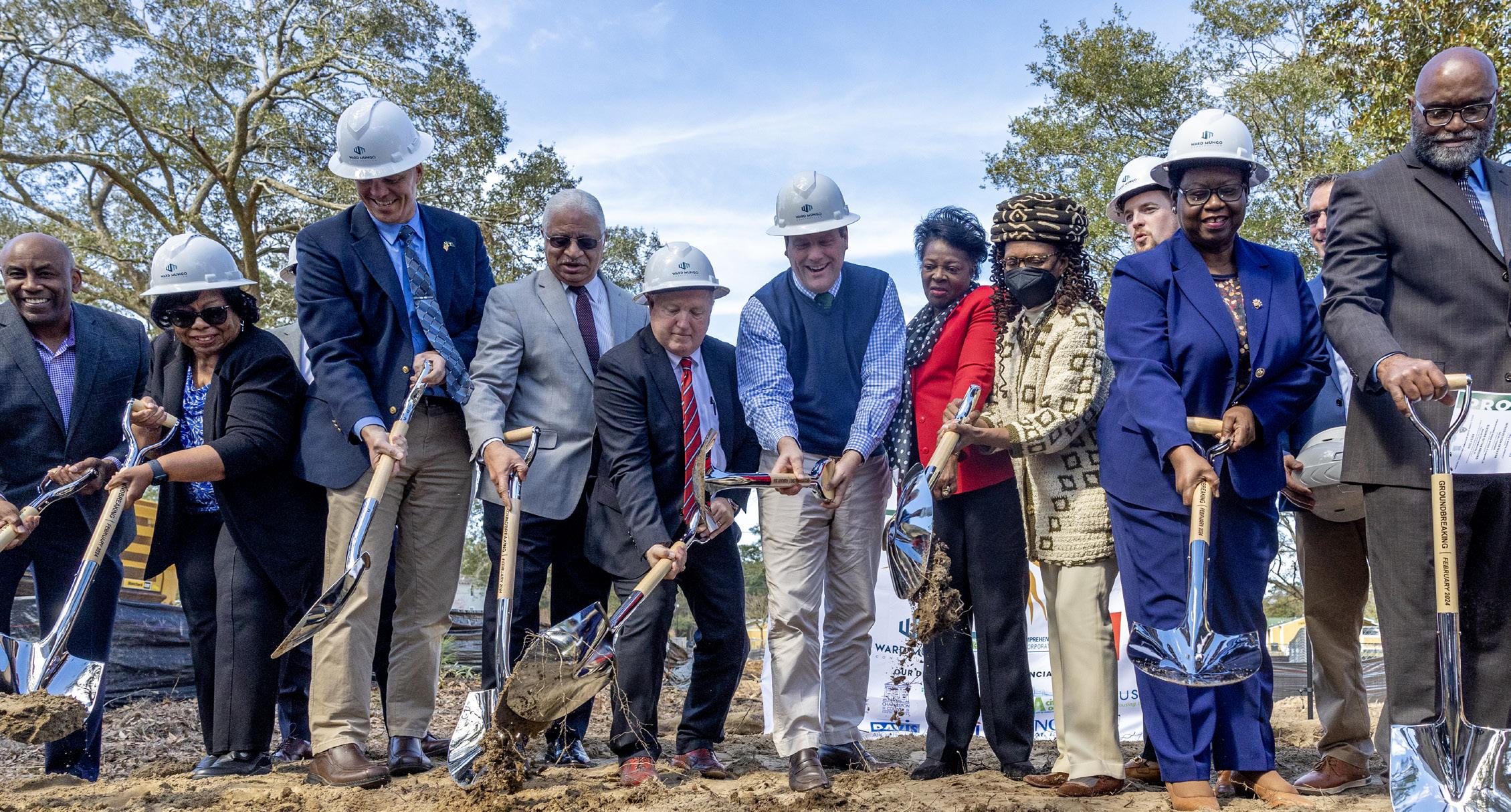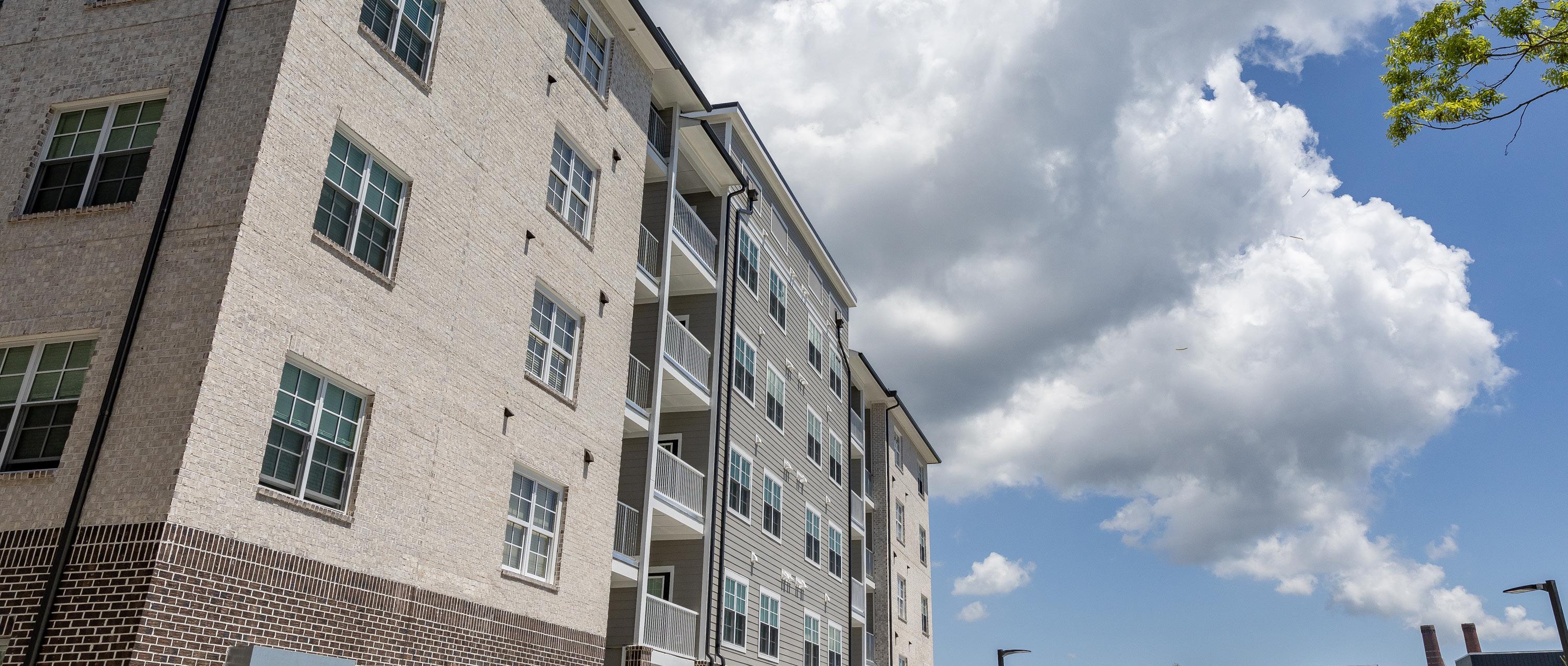






The South Carolina State Housing Finance and Development Authority (SC Housing) is a selfsustaining agency committed to ensuring that South Carolinians have the opportunity to live in safe, decent and affordable housing. SC Housing operations are supported by a funding base that includes fees and other revenue earned through the administration of agency programs.
Mission:
Create quality affordable housing opportunities for the citizens of South Carolina.
Vision Statement:
That all South Carolinians have the opportunity to live in safe, decent and affordable housing.
Our Values:
COMMUNITY
We help make big cities and small towns across the Palmetto State better places to live.
INTEGRITY
We act ethically in everything that we do and treat our partners and customers with respect.
INNOVATION
We are deeply motivated to pursue new and better ways to serve the people of our state.
PROFESSIONALISM
We perform our tasks effectively and efficiently and steward resources responsibly.
EXPERTISE
We are capable, resourceful and deeply informed about housing issues in South Carolina.
The affordable housing landscape has changed considerably since the COVID-19 pandemic, requiring realignment of agency resources and strategies to better meet housing needs and priorities in the state. As SC Housing moves forward, our planning is informed by current housing trends, market conditions and the need to better leverage available public and private resources and capacity. We recognize that implementing sustainable and impactful affordable housing solutions will require input and support from a broad range of community partners, including private business, developers, local government, non-profits and our sister state agencies. Findings from the recently released Palmetto State Housing Study indicate that housing needs, resources and affordability challenges vary across regions in our state, and so do solutions.
This plan offers the opportunity for shared solutions and collaborative planning among affordable housing partners. It should be viewed as a roadmap with mile markers where we collectively evaluate the path forward in response to changing market conditions and the unique needs of each local community. It is also dynamic and responsive to emerging housing needs and challenges, leaving room for the negotiation of collaborative strategies. It is intentionally flexible so that realignments, recalibration and course adjustments can be made along the way to meet the needs of the citizens that we serve—a practice that enabled our state to effectively navigate the pandemic and the uncertainties that it ushered in.
The SC Housing leadership is committed to keeping the lines of communication open with our partners and customers. We believe that it is critical that we communicate about proposed actions and evaluate proposals from various vantage points in order to explore impact and costs. For this reason, the plan specifies goal statements that reflect our policy priorities along with strategies that outline how the agency plans to get to the desired outcome. Specific initiatives will be identified through collaborative program planning efforts with partners.
We want to ensure that our partners, customers, advocates and other key stakeholders have the opportunity to bring their expertise, resources and voices to the process. Buy-in is an important part of any successful planning effort and SC Housing intends to offer opportunities for these conversations to occur before initiatives are adopted. Updates on specific initiatives will be posted on the SC Housing website.
While the process that supports this plan is flexible and fluid, the plan will be implemented within an accountability framework that provides the public with visibility into the results of our program efforts. Concurrent with the implementation of this plan, the agency is piloting a new Economic Impact Analysis Interactive Tool that allows the public to view the impact of our programs by county, SC House District, SC Senate District and U.S. District for each fiscal year. This easy-to-use tool provides transparency as to the results achieved from our investment of resources in the core areas outlined in this plan: Programs, People, Finance, and Information Technology

Affordable housing is impacting virtually every sector of our community, from individuals and families in need of workforce housing because they can no longer afford to live near their jobs, to cities and counties challenged with not having enough affordable housing to keep pace with demand.
According to the Palmetto State Housing Study, commissioned by the state legislature and undertaken in FY2023, South Carolina has experienced an unprecedented population explosion that began in 2010 due to the in-migration of residents moving here from other parts of the United States. They are moving here because of our “relatively low cost-of-living, a strong economy and many natural amenities” that make life in the Palmetto State attractive. This in-migration pattern is impacting housing needs, driving up prices and widening the affordability gap, particularly for low-income households making less than $35,000. The study also found that 43.3% of moderate-income ($45,000-75,000) single-parent households with children are housing cost-burdened, or spending more than 30% of their income for housing costs. This suggests the need for more workforce housing tied to both demand and supply.
The study described the affordability challenge in our state this way, “approximately 50 percent of renting households and 25 percent of households with a mortgage are housing cost burdened in South Carolina.” Also, there is a significant demographic shift to an aging population with unique housing needs that will need to be considered. This represents the demand side of the equation.
The study also asserts that the low affordable housing supply in our state, as well as the nation, is due to significant underbuilding that, since 2008, has not kept pace with growth. South Carolina’s population growth rate increased by 16.4% between 2010-2021, representing 650,000 new residents, exceeding
the national population growth rate of 11.3% for this same period. The study also found that there is a diminishing supply of homes at the lower price point of under $100,000—a decrease of 14.8% since 2014. It is estimated that the average price of a starter home is now around $250,000, with rising interest rates further impacting affordability.
The most pronounced influx of residents was to the Coastal, Upstate and Midlands regions, with nearly 90% of the state’s residents living in only half of its 46 counties. The study also concluded that urban areas in our state are most in need of new construction, whereas the rural areas need preservation of existing housing, with home repair being the most prevalent need expressed by residents.
Many of these findings are reflected in other national studies as well. The State of the Nation's Housing 2023 Report, released by the Harvard Joint Center for Housing Studies, states that higher prices are putting homeownership out of reach and that construction of single-family homes is slowing down. While multifamily development is progressing in our state—due to the state tax credit and legislation that provided one-time, supplemental funding for certain multifamily housing projects impacted by the recent COVID-19 pandemic—rising construction and insurance costs are still concerns for developers.
SC Housing creates quality affordable housing opportunities through a broad range of programs that provide:
• Competitive market-based financial products for homeownership;
• Comprehensive home repair programs to correct life, health and safety concerns and provide accessibility;
• Financing of supportive housing programs that include needed services for vulnerable residents;
• Financing of multifamily projects to increase the availability of quality rental homes; and
• Monitoring of properties to ensure that living conditions are safe and habitable, and that rent remains affordable over time.


Through the Homeownership Program, the agency provides funds to participating private mortgage lenders to assist low- and moderate-income homebuyers with what is often the purchase of their first home. This is primarily done by offering 30-year fixed-rate mortgages with competitive interest rates that include down payment assistance, reducing the amount of savings necessary to make homeownership attainable. Eligible properties include site built single-family homes, off-frame modular homes, patio/townhomes and approved condominiums. The program also offers additional down payment assistance in certain underserved rural counties to incentivize homeownership (County Rural Initiative Program), as well as a seasonal program, Palmetto Heroes, which serves teachers, first responders, nurses, emergency medical technicians, correctional officers, veterans and other community service personnel to help bring homeownership within reach.
The program works closely with the agency’s Finance and investor team to design mortgage products to address the varying needs of potential homebuyers. One such example is the Palmetto Home Advantage (PHA) program, which provides alternative financing for the purchase of mortgage loans. It is self-funded via mortgage backed securities transactions, which removes some of the restrictions that govern traditional lending options available through SC Housing. Homebuyers may borrow up to 97 percent of the home’s value and can remove their private mortgage insurance payments (on conventional loans) once the homeowner has 20 percent equity.
In response to high interest rates and rising home prices, the agency launched another mortgage option in November 2023 — the Reduced Interest Rate Homebuyer Option, which is available for eligible FHA/ VA and USDA first mortgage loans only. Qualified participants can take advantage of a lower interest rate mortgage option without down payment assistance. Homebuyers must use their own funds (including eligible gift funds) for down payment and closing costs. The program helps first-time homebuyers to break into the market with a more manageable monthly payment. The program is also attractive to veterans, who can purchase a home using their VA loan with no down payment and a lower interest rate.
Expand homeownership opportunities for low-to-moderate-income households by creating affordable home purchase options, mortgage products and retention support services that make homeownership attainable and sustainable for a broad range of potential homeowners.
Enhance Homeownership Opportunities by encouraging homeownership through increased mortgage loan volume and down payment assistance to low-to-moderate-income South Carolinians.
Work to expand affordable homeownership through various financing mechanisms and the development of programs that both support low-to-moderate-income homebuyers and attract industry participants such as private lenders and real estate professionals.
Work to expand affordable homeownership through various financing mechanisms and the development of programs that both support low-to-moderate-income homebuyers and attract industry participants such as private lenders and real estate professionals.
Increase the number of affordable homes available for sale by supporting the creation of more affordable options, including manufactured/modular homes, townhomes and condominiums.
Advocate for additional funding to develop and subsidize owner-occupied housing and work with industry and government partners to reduce the cost of housing development.
Effectively and proactively service all mortgage loans to ensure superior customer service in an effort to assist with homeowner retention.
Stay abreast of all industry updates, work to educate new mortgagors in order to assist them in becoming successful homeowners, and mitigate foreclosures by providing all available loss mitigation options when default is imminent.

Development oversees a number of programs that support the construction, financing, rehabilitation and repair of housing for low-income households across South Carolina. These programs generally serve families whose household income is at or below 80 percent of the area median income (AMI), depending upon each program’s specific income requirements.
The Low-income Housing Tax Credit (LIHTC) Program is a federal program that helps build or preserve thousands of units in South Carolina every year. Credits are made available in two ways: the “9 percent” credit, which is awarded on a competitive basis once per year and is designed to cover about 70 percent of project costs, and the “4 percent” credit, which is designed to cover 30 percent of project costs and is paired with Tax Exempt Bonds to cover the remainder. Real estate developers submit applications to SC Housing to apply for LIHTC and are approved for a tax credit award based upon selection criteria outlined in the state’s Qualified Allocation Plan (QAP).
The South Carolina State Housing Tax Credit for affordable housing development was created by the Workforce and Senior Affordable Housing Act, which was signed by the Governor on May 14, 2020, as Act 137; and was subsequently revised by Act 202 on May 31, 2022, and Act 88 on May 19, 2023.
Developers who receive federal housing tax credits through the LIHTC program can also request state tax credits to support their eligible projects.
The South Carolina Housing Trust Fund (SCHTF) is funded by a portion of the documentary stamp tax on real estate transactions. Its purpose is to assist low-income households throughout the state by providing financial assistance for the development, rehabilitation and preservation of safe, decent, sanitary and affordable housing, leveraging outside dollars to support these efforts. SCHTF funding is administered through a network of non-profit and for profit entities, along with local governments, that provide assistance to eligible low-income households for critical home repairs. The Supportive Housing Program also funds new construction, acquisition and acquisition/rehabilitation of rental housing that provide access to supportive services for special needs populations, such as people with disabilities and people experiencing homelessness.
The Small Rental Development Program (SRDP) allows the agency to fund a broader range of rental housing by combining state and federal funding sources to provide a flexible source of financing for smaller rental properties. The funding programs that support SRDP include the South Carolina Housing Trust Fund (SCHTF), the National Housing Trust Fund (NHTF), and the HOME Investment Partnerships program (HOME). Both NHTF and HOME are administered by the U.S. Department of Housing and Urban Development (HUD).
HOME Investment Partnerships Program provides formula grants to states, counties, and cities for expanding the supply of affordable housing for low-income households. Funds can be used to address a broad range of activities including rental housing development.
HOME Investment Partnerships American Rescue Plan Program (HOME-ARP) is appropriated through the American Rescue Plan Act of 2021, HOME-ARP provides funding to assist individuals and households who are homeless, at risk of homelessness, and members of other vulnerable populations to provide housing, supportive services, and tenant-based rental assistance. HUD has allocated $26.6 million in funding to SC Housing for the development of rental housing.
The National Housing Trust Fund (NHTF) is a federal resource that provides financing for rental housing serving extremely low-income households (no more than 30 percent of AMI).
To improve housing affordability and availability statewide through partnerships with public and private entities that promote production and preservation of affordable housing stock that meets industry standards for safety and quality�
Utilize data from the Palmetto State Housing Study and other relevant sources to design programs and direct resources to develop affordable housing where it is most needed and efficiently utilized.
Use quantitative resources to ensure that program funds are allocated to communities throughout the state in most need of affordable housing. Continually reevaluate data-driven strategies for cost containment while maintaining the financial stability and physical condition of low-income housing.
Strengthen partnerships with internal stakeholders, affordable housing developers, other state agencies, advocacy groups, local governments, etc. to ensure programmatic effectiveness.
Implement a request for qualifications process to identify high-capacity nonprofits and contractors to participate in programs administered by the division. Continually increase awareness of programs and their requirements by utilizing technology to develop easily accessible technical assistance opportunities through the use of online platforms, and conducting events throughout the year. Incentivize leveraging of non-SC Housing funding sources, including gap funding, to increase the supply of affordable housing units.
Support the growth and health of the State Tax Credit Program.
Maintain the State Tax Credit Program to leverage LIHTC and tax-exempt bonds to maximize allocation of available bond cap proceeds. Develop and implement a gap financing program to assist with the rising cost of building affordable single and multi-family homes. Work with external stakeholders in state government and the private sector for improvements to vetting, awarding and constructing multifamily projects statewide.
Continue to research ways to further expand development for housing projects that target the state’s most vulnerable populations through flexible program design.
Partner with sister agencies, local governments, non-profits and private business in creative and innovative ways to utilize SC Housing resources to meet the needs of different regions of the state and for differing needs of individuals who are housing cost burdened or housing unstable. Leverage existing technology resources to implement an efficient online application submission for multifamily rental development activities. Develop a Multifamily Preservation Strategy, including the types of housing to be prioritized and potential funding sources, along with an outreach and communication plan.

Rental Assistance and Compliance administers programs that ensure properties funded and/or monitored by SC Housing are properly maintained and comply with applicable federal and state health, safety and quality standards, ensuring that tenants can stay safely in their homes. This program area also ensures that rent amounts remain affordable based upon HUD requirements and administers rental subsidies on behalf of these residents. The program maintains a statewide hotline for resolution of tenant complaints in partnership with the appropriate regulatory agents. The following three programs are administered through this area:
SC Housing oversees the Housing Choice Voucher Program (HCVP) in the seven counties that do not have a local participating public housing authority: Clarendon, Colleton, Dorchester, Fairfield, Kershaw, Lee and Lexington. This is a federal program operated by HUD that provides rental assistance to eligible households to cover the gap between the rent charged and 30 percent of their income; ensuring the tenant does not experience housing cost burden. These families and individuals live in privately-owned properties, both single-family homes and apartment buildings.
SC Housing monitors a portfolio of approximately 270 Section 8 rental properties across the state on behalf of HUD through the Project-Based Contract Administration (PBCA) Program HUD provides SC Housing with funds to review and approve monthly housing assistance payments, conduct Management and Occupancy Reviews to ensure compliance with federal law, serve as an ombudsman for tenant concerns, oversee subsidy contracts with property owners and support the Project-Based Section 8 program as a whole in South Carolina.
Compliance Monitoring ensures that properties receiving funding from SC Housing’s Development Division meet state and federal laws, regulations and requirements. Their duties consist of on-site inspections to ensure the properties meet the health and safety standards; a thorough review of property managers’ files to validate that the right affordable rents have been charged and that tenants are income-eligible to live in their homes; and follow-up on tenant concerns and other regulatory requirements.
Support affordable housing initiatives throughout South Carolina while ensuring compliance with state and federal regulations for the benefit of both our housing partners and their residents.
Enhance efforts to expand the inventory of affordable rental housing stock.
Foster and cultivate program participation among rental property owners through relationship building and training. In conjunction with internal stakeholders and external partners, develop and implement an information campaign to highlight the need for additional landlord participation.
Continue to surpass federal regulatory requirements for the administration of rental assistance programs through the ongoing application and improvement of internal quality control procedures, thereby meeting and exceeding the agency’s contractual obligations.
Ensure all Performance-Based Contract Administration regulatory and contractual requirements meet the Acceptable Quality Level (AQL) for each Incentive-Based Performance Standards (IBPS) task and facilitate the maximization of fees earned. Improve area controls, training and the review process for the Section 8 Tenant-Based Voucher Program. Employ all electronic resources available to sustain program growth and improve productivity and efficiencies. Ensure accountability and overall compliance with the 14 Key Performance Indicators utilized by HUD.
Maximize tenant safety, affordability and quality of life by consistently enforcing federal and state requirements of rental development programs by leveraging all vested authority to remedy chronic or severe noncompliance.
Maintain a system for reporting and escalating unresolved chronic or severe noncompliance for additional enforcement actions. Provide targeted incentives for owner/agents to secure compliance with minimum property standard requirements.

Attract, hire and retain talented and engaged employees, fulfilling the staffing needs of the agency without interruption.
Outreach to potential talent pools and implement onboarding process for new hires.
Collaborate and build relationships with local technical schools, colleges universities, and/or community outreach groups to recruit top talent, entry-level hires and interns. Improve the onboarding process that creates an engaged and motivated workforce.
Create and implement training and development program for agency employees.
Create and implement a training and development plan to improve the knowledge, skills and abilities of SC Housing’s leaders and employees. Continue to streamline and facilitate the agency’s internal leadership development program for individual contributors, managers/supervisors, junior leadership and senior leadership. Create and implement agency-wide training programs to support a healthy work environment.
Planning and Talent Review Process (TRP).
Create and implement a succession plan and talent review process that allows the agency to review key roles and determine the readiness levels of potential internal candidates.

Provide accurate and timely financial and operational reporting to allow management to make informed business decisions.
Review transaction mapping for single family programs to facilitate analysis of margins for mortgage servicing and loan origination in order to plan for funding of future production.
Develop template/model for revenue and expense analysis by program area to determine optimal resource utilization and facilitate operational planning both short and long term.
Explore approaches to incentivize production of affordable single family homes for first time homebuyers and maintain the affordability of those homes long-term.

To enhance SC Housing’s programs and services by implementing technology infrastructure, initiatives and solutions that align with the agency’s strategic goals and support the execution of vital business functions.
Strategy 1:
Operate with an agency-wide vision by leveraging opportunities for consolidation and identification of opportunities for departments to better integrate sharing of data and information across platforms.
Formalize security management to structure protection for vital business systems to include annual penetration testing, vulnerability scanning, log reviews and testing of the IT disaster recovery plan.
Implement well-planned decision process for IT resources, ensuring budget transparency and alignment of allocations programmatically with proper prioritization and planning. Set targets, budgets and performance tracking of technology solutions.
Complete agency wide review of current systems to support various activities within all programs, to include web-based solutions of agency services. Determine effectiveness of systems and potential alternatives.

